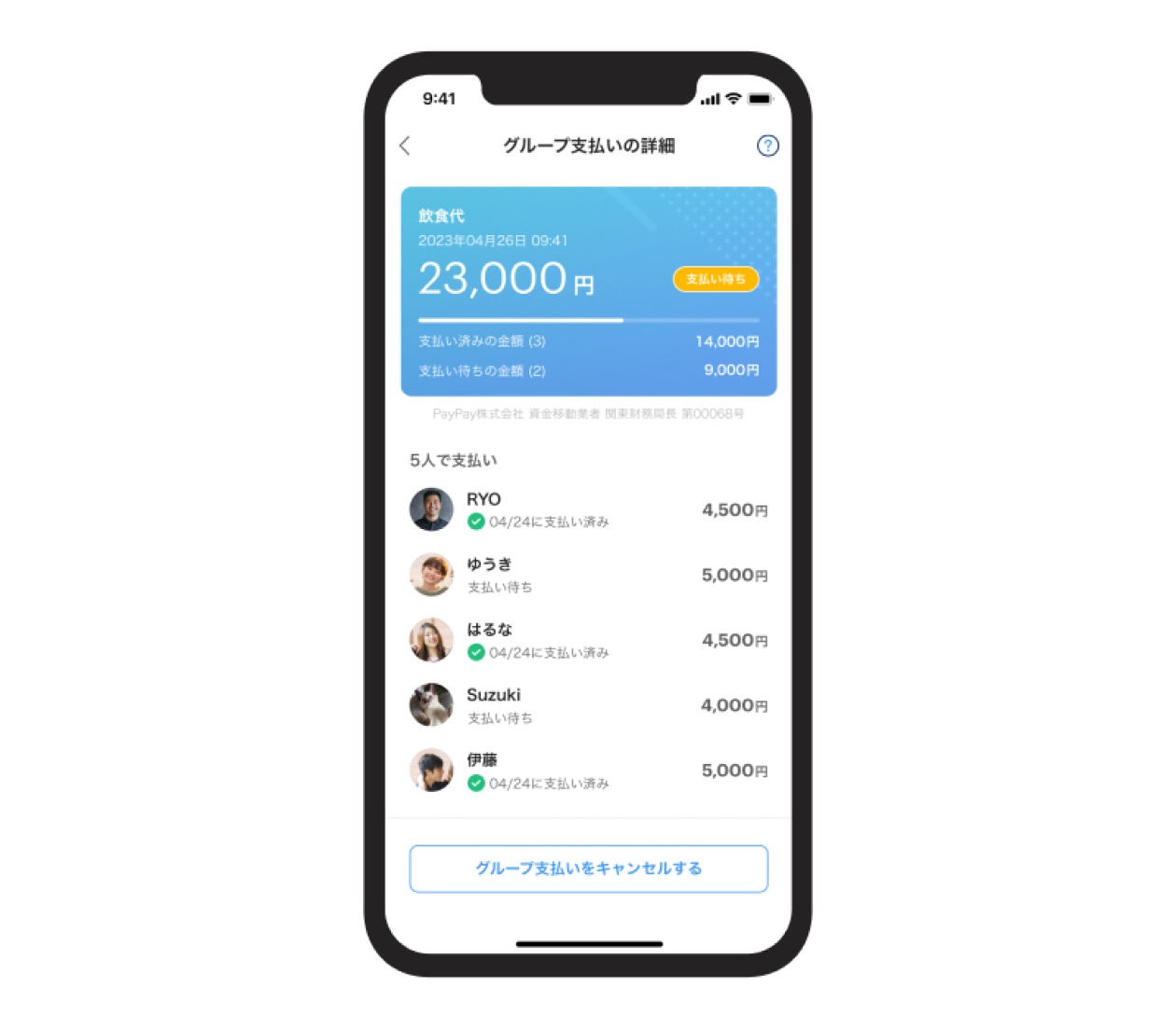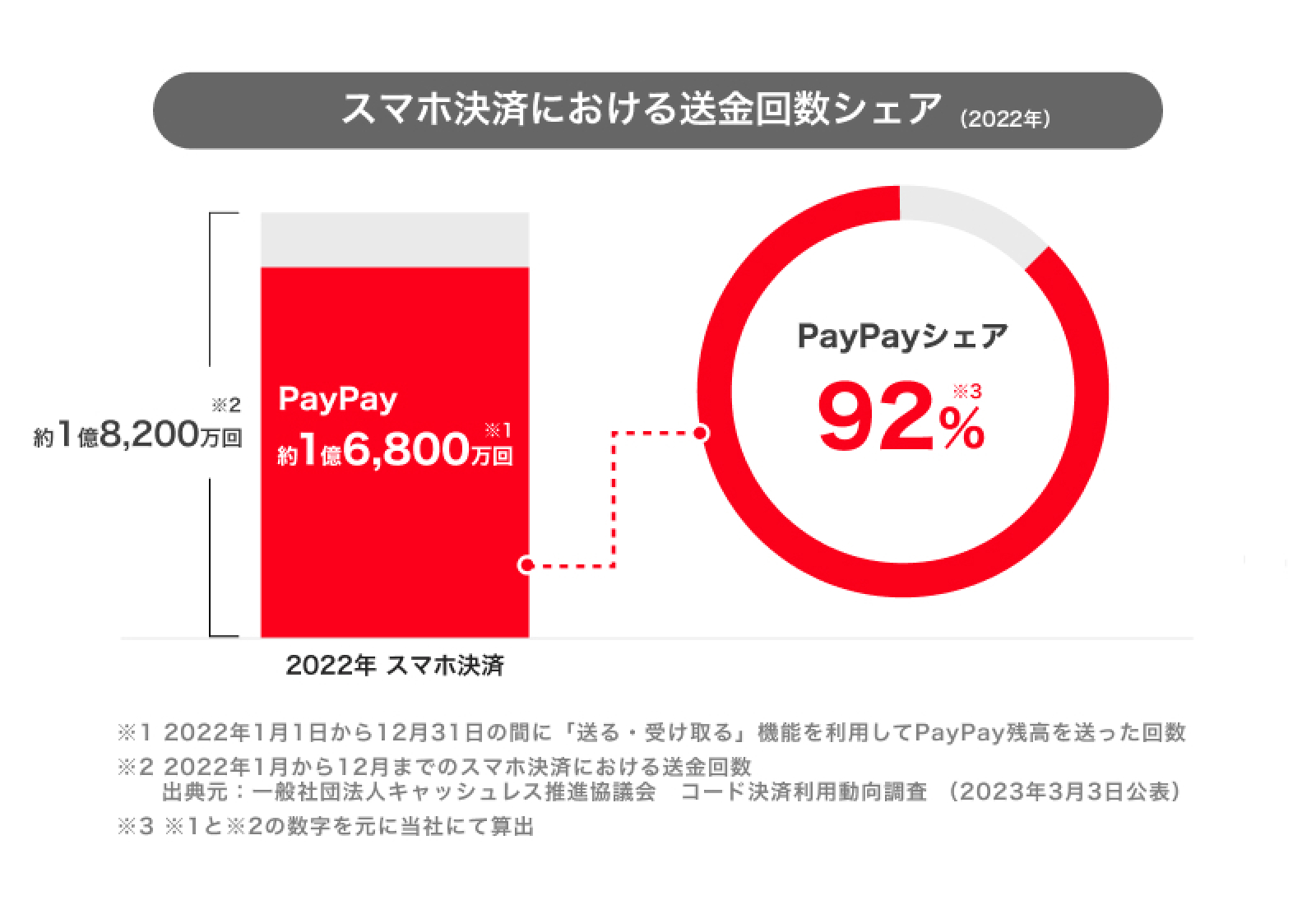PayPay Corporation is pleased to announce that it has launched “Group Bill*1”, which allows users to conveniently use the group chat within the “Send/Receive” feature to split a bill among friends.
With the launch of this feature, users can set the amount to be paid by each member of the group and see which members have already paid, preventing missed payments. *For more information on how to use “Group Bill,” please click here.

The number of PayPay users who have used “Send/Receive” topped 26 million*2, and the number of remittances made in FY2022 increased approximately 1.9 times year-on-year, to approximately 200 million. This is due to the service’s ease of use for transactions between PayPay users, such as the ability to specify the amount in units of 1 yen, free remittances for any amount, and 24/7 availability all year round. Since its launch in November 2018, various new features—including chat, automatic receipt, and scheduling—have been added for the convenience of users. Thanks to many people choosing “PayPay” as a means of remittance, the PayPay app’s share of the number of remittances among mobile payment services in 2022 exceeded 92%*3.
In addition to splitting the cost of meals and trips with friends, an increasing number of families are using the service, such as for managing living expenses between married couples and giving an allowance to children. In recent years, remittances for giving otoshidama (New Year’s money for children) has been on the rise, and the number of remittances of amounts presumed to be otoshidama*4 between January 1 and 3, 2023 was approximately 1.6 times greater year on year, indicating that the service is used across multiple generations.
PayPay will continue to update the “Send/Receive” feature for it to be available in various situations where money is concerned.
*1. This is a renewal of the “Warikan (Split Bill)” feature that has been offered since April 2019. “Warikan,” which has already suspended the creation of new split bills, will be discontinued on May 31, 2023. For information on how to create a group chat, please see here.
*2. As of March 2023.
*3. The share of “PayPay” was calculated by PayPay based on the publication by PAYMENTS JAPAN, “Stats – Code Payment,” published on March 3, 2023.
*4. Comparison of the number of remittances in the amounts of 1,000 yen, 3,000 yen, 5,000 yen, and 10,000 yen.
*When sending PayPay Money balance, it is a “remittance,” and when sending PayPay Money Lite balance, it is a “transfer.” Please refer to the PayPay Balance Terms of Use for details.

PayPay will continue to offer the convenience of cashless payments to users as well as all kinds of retailers and service providers, with the goal of creating a world in which a safe cashless shopping experience can be enjoyed anywhere in Japan. “PayPay” will continue on the path to evolve from a “payment app” into a “super app” that will make users’ lives richer and more convenient, fostering a culture of “Anytime, Anywhere with PayPay.”
■ About “PayPay,” the cashless payment service provided by PayPay Corporation
PayPay is a cashless payment service expanding across the country, available not only at major chain stores but also at small and medium size retailers, vending machines, taxis, and even public transportation. It can also be used in a variety of other situations, including paying for online services and utility bills. PayPay is also expanding its range of services beyond just payments, including a “send/receive” feature (remittance/transfer and receiving of money) that allows users to transfer their PayPay Balance (PayPay Money and PayPay Money Lite) between each other for free, or “point management,” a service that allows users access to a simulated investment experience involving the exchange of PayPay Points with points provided by a service provider that PayPay is partnered with. The company also strives to create a safe and convenient environment for users through a hotline available 24/7 and a full compensation scheme ensuring, compensation for any damages that may be suffered.
PayPay Corporation is registered as follows:
・Prepaid Payment Instruments (third party type) Issuer, Registration #: Director-General of the Kanto Finance Bureau, No. 00710 (Registration date: October 5, 2018)
・Business Operator that Concludes Contracts on the Handling of Credit Card Numbers, etc., Registration #: Kanto (K) No. 106 (Registration date: July 1, 2019)
・Telecommunications Carrier (Filing #: A-02-17943 / Date filed: July 2, 2019)
・Fund Transfer Operator, Registration #: Director-General of the Kanto Finance Bureau, No. 00068 (Registration date: September 25, 2019)
・Notified Person Entrusted with Intermediation (Filing #: C1907980 / Date filed: December 18, 2019)
・Bank Agency Operator, License: Director-General of the Kanto Finance Bureau, No. 396 (Registration date: November 26, 2020)
・Financial instruments intermediary service registration number: Kanto Finance Bureau Director (Kinchu) No. 942 (Registration date: June 25, 2021)
・Japan Payment Service Association (https://www.s-kessai.jp/, Date of admission: September 12, 2018)
・Japan Consumer Credit Association (https://www.j-credit.or.jp/, Date of admission: July 1, 2019)
* “PayPay” provides 5 types of PayPay Balance: PayPay Money, PayPay Money Lite, PayPay Points, PayPay Bonus Lite, and PayPay Gift Voucher.
PayPay Money can be used to pay for partner services and merchants if it is within the amount deposited into the PayPay account opened after completing an identity verification process. It can also be used for sending and receiving money between PayPay users free of charge. PayPay Money can also be cashed out to a designated bank account (no withdrawal fee if using PayPay Bank). The legal nature of this is an electromagnetic record which can be used to pay for goods and other services, and can be remitted or cashed out, and is issued by PayPay who is a Fund Transfer Operator registered under Article 37 of the Payment Services Act. Based on the provisions of Article 43 of the Payment Services Act, PayPay protects the debt it owes to its users in by depositing assets equivalent to or more than the debt amount. PayPay Money Lite is an electronic money issued by PayPay, which can be purchased and used to pay for services and merchants. PayPay users can transfer and receive PayPay Money Lite free of charge. The legal nature of this is a prepaid payment instrument issued by PayPay (Article 3, Paragraph 1 of the Payment Services Act). Based on the provisions of Article 14 of the Payment Services Act, PayPay preserves the relevant assets for the purpose of protecting the owners of the prepaid payment instrument by providing a security deposit for issuance to the Legal Affairs Bureau in an amount that is half or more of the unused balance of prepaid instrument methods as of March 31 and September 30. In addition, PayPay Points and PayPay Bonus Lite, which are granted through campaigns and promotions when using PayPay, can be used for partner services and in transactions at merchants in addition to PayPay Money and PayPay Money Lite. However, PayPay Bonus and PayPay Bonus Lite cannot be sent or transferred between PayPay users or be cashed out. PayPay Bonus Lite has an expiration date, after which it will no longer be valid. PayPay Gift Voucher is a type of electronic money issued by PayPay, which can be used to make payments for affiliated services and merchants designated by the PayPay Gift Voucher. However, it cannot be transferred to other users or cashed out. PayPay Gift Vouchers are valid for six months after issuance, after which they will no longer be valid.
PayPay also strives to create a safe and secure environment for users. If an unexpected payment is made by a third party using a PayPay account, or if a request to settle a payment suddenly arrives from PayPay to a user that does not have a PayPay account, providing that certain conditions are met, the user can be compensated for the damages suffered (the difference will be provided as compensation if compensation is also provided by a third party). Please see applying for compensation for details.
*Company names, trade names, and products/services in this press release are registered trademarks or trademarks of their respective companies.





